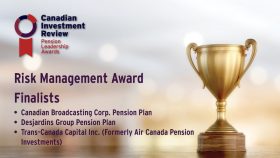

The Canadian Investment Review’s Risk Management Award will go to a pension plan that has successfully implemented a robust approach to its risk management function. This can include implementing de-risking or re-risking or it can showcase day-to-day processes in place for risk management in pension plan investments.
Highlights about the three finalists are available below:
Canadian Broadcasting Corporation Pension Plan
The CBC pension plan has over $8 billion in assets under management, with $3.8 billion of that managed internally. The plan is indexed to inflation and is very mature with a negative cash flow. The pension plan has 50/50 cost-sharing between the plan sponsor and employees and funding stability is of great importance. The CBC pension plan has implemented a liability-driven investment strategy that hedges most interest rate and inflation risks. It has rigorous risk management processes in place including regular asset and liability matching assessments, comprehensive annual reviews of the investment policy, quarterly assessments of the interest rate hedging effectiveness, quarterly reports to the board of trustees, monthly exposure analysis, including counter-party credit risk, weekly tracking of the plan’s solvency liabilities; and quarterly rebalancing of the hedge ratio to contain the interest rate risk. Over time, the plan has improved its funding position, reaching full solvency funding in 2018 without reducing benefits or making any additional contributions to fund solvency deficits.
Desjardins Group Pension Plan
The Desjardins Group Pension Plan has $16 billion in assets under management and is still open to new entrants. Over the past number of years, it has taken a de-risking journey. Prior to this journey, assets were managed on one side of the organization and liability valuation was done on another side. The organization established an internal team responsible for managing strategy, overseeing risks and bridging the gap between assets and liabilities. The risk team, which now has eight people, did research and improved the plan’s liability-driven investing strategy. Over the past 10 years, the assets of the plan have grown by over $10 billion and the going-concern, solvency and accounting ratios have improved significantly. The pension plan now has more direct capacity for financial research and modelling for its risk framework. It has also developed tools that model the behaviour of asset classes, the three liability valuations and the common variables or risk factors.
Trans-Canada Capital Inc. (Formerly Air Canada Pension Investments)
In 2009, the Air Canada pension plan, comprised of eight defined benefit plans, was in a severe solvency deficit. In response, the company hired a new investment team to implement an investment strategy, which used derivatives and leverage, to achieve better returns and lower the pension plan’s risk. It significantly decreased exposure to equities, introduced alternative asset classes and increased its allocation to liability-matching assets. It also diversified its sources of active risk and reduced the overall risk compared to liabilities by more than half. Over time, the investment team has helped turned the pension plan around, eliminating a $4.2 billion deficit and reaching a surplus of $2.6 billion by 2019. The plan now has $22.5 billion in assets under management and uses a holistic risk management approach. It has fully integrated risk management throughout its investment process and also recently expanded its compliance team as an additional line of defence.
To find out who wins, register today for the Defined Benefit Investment Forum, which will feature the Pension Leadership Awards Ceremony. Learn more: http://www.investmentreview.com/conference/defined-benefit-investment-forum-2020
